This was published 4 years ago
Pilgrimage of a lifetime: How and why you should walk Spain's famous Camino de Santiago
By Alison Stewart
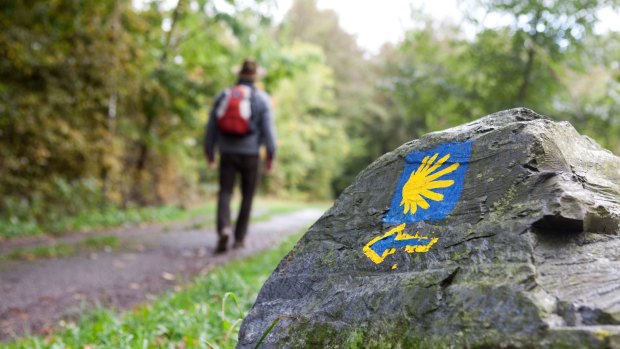
Walking the Camino de Santiago trail.Credit: Alamy
There is an inscription on the path into Santiago de Compostela, capital of north-west Spain's Galicia region and the culmination of the Camino de Santiago, that states Europe was built on the famed pilgrimage route.
Perhaps it was Europe's character itself that was shaped as people made their way towards acceptance and renewal. For about 1200 years, myriad paths have streamed towards the "field of the star", the light in the darkness – Santiago, the radiant destination for Camino pilgrims.
Here, the bones of St James, one of Jesus' 12 apostles, are said to be buried, once a mighty talisman for the medieval faithful fearful of Moorish dominance. The St James Way joined Jerusalem, Rome and Canterbury as a major medieval pilgrimage route. It sprang from a crusading religious fervour, coinciding with the battles between Muslims and Christians on the Iberian Peninsula.
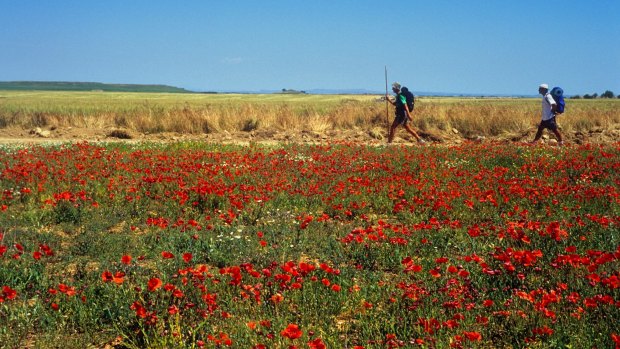
Pilgrims between Hornillos del Camino and Hontanas, Spain.Credit: Alamy
Christians were outnumbered and demoralised, believing Muslim forces in Cordoba possessed powerful relics – Mohammed's arm bone and an original copy of the Koran. The discovery of the St James bones gave rise to the belief that he had come from heaven, armed with a sword to lead Christians to victory. He was called St James "Matamoros" – the Moor slayer, giving rise to violent statues and paintings, some of which survive.
But the Way is no longer about war, fanaticism or religious ascendancy. Today's pilgrims walk arguably in what was always the true spirit of pilgrimage – for acceptance, forgiveness and redemption. And in the case of my friends, utter generosity.
We're not all religious pilgrims. Many simply take a secular journey in search of a better place physically, spiritually and psychologically. Some of us just go for the hike although walking the Camino, any Camino, seems to inspire acts of humanity (I witnessed it while walking a section of France's Le Puy Camino when my partner, recovering from illness, persevered thanks to the patience of friends who themselves were struggling with injury and setback).
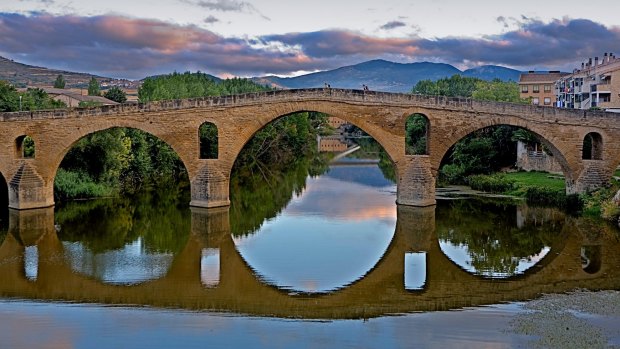
Puente la Reina, Navarra, Spain.Credit: Alamy
If we allow it, our better selves emerge when framed by such a journey. Perhaps that is why there are so many Caminos – through the millennia, people have walked through adversity in search of transformation.
And even before Christianity, people were drawn to the quest – making their hopeful way to Stonehenge, Olympus and Delphi. In fact, all religions celebrate pilgrimage, which is integral to the human condition.
Is it coincidental that in the increasing clatter of our frantically material world, the popularity of pilgrimage has boomed? People of all ages and walks of life from more than 130 countries now attempt the Way of St James in some form.
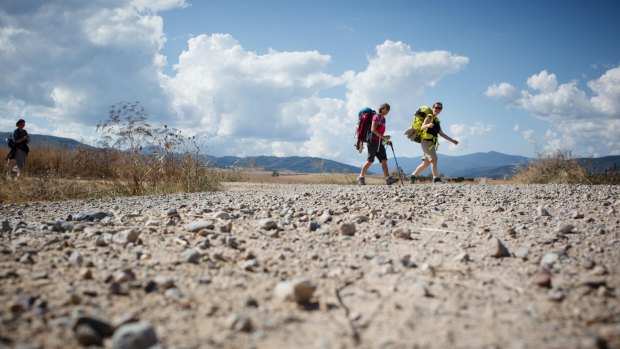
Camino de Santiago, near Santo Domingo de la Calzada, Spain.Credit: Alamy
It's a chance to think, to meet others who might share their stories without judgment, to acknowledge frailties, forgive and be forgiven and address the difficulties not just of the journey, but of life.
Indeed, Santiago's office of pilgrims reports that 327,342 pilgrims arrived in Santiago in 2018, an increasing number and possibly an underestimate as not all walkers claim the Compostela, the certificate of completion. Pilgrims receive such a certificate on presenting their "Credencial del Peregrino" containing the required number of daily stamps (sello). In 2005 by comparison, 79,393 collected their Compostela.
Camino walking has become ridiculously popular, especially since Emilio Estevez's 2010 film, The Way, starring Martin Sheen, and the proliferation of books and documentaries on the subject.
It's also ferociously complicated. To the uninitiated, the Camino is Martin Sheen's Camino – the Camino Frances or French Way. Caminos, however, are etched into Europe's landscape as graffiti may be etched into wooden school desks.
People still walk the 1900-kilometre Via Francigena from Canterbury to Rome across four European countries (it's a European Cultural Route) but the Camino de Santiago now wears the crown in terms of "walking the Camino". The Camino Frances and routes of Northern Spain have been UNESCO world heritage-listed.
The question is why people keep returning to walk the Jacobean Camino, sometimes the same route but often one of the many different ways? How many ways are there? A pilgrimage begins when you leave your home but infrastructure-wise, there are seven well-established routes and more than a score of other lesser-travelled routes.
WHICH CAMINO DO I CHOOSE?
The most popular of the well-established ways is the 798-kilometre Camino Frances or French Way (60 per cent of pilgrims walk it), which runs from Saint-Jean-Pied-de-Port on the French side of the Pyrenees to Roncesvalles on the Spanish side, then on to Santiago. It passes through the cities of Pamplona, Logrono, Burgos and Leon and takes at least four weeks to walk.
Paths from the French cities of Tours, Vezelay and Le Puy-en-Velay meet at Saint-Jean-Pied-de-Port while a fourth route begins in Arles in Provence and crosses the border at a different point, following the lesser Aragonese Way to join the French Camino about 700 kilometres from Santiago. (Le Puy-en-Velay to Santiago is about 1540 kilometres).
The French Way is the oldest recorded pilgrimage from France to Santiago made in 950 AD by Bishop Godesclac from Le-Puy-en-Velay in the Auvergne region.
Many only walk the last 100 kilometres to 200 kilometres. The last 100 kilometres to Santiago is the minimum distance required to earn a Compostela, 200 kilometres if you're cycling. Ninety-four per cent of pilgrims walk but other modes include bicycles and horseback, while a tiny minority complete a Camino by wheelchair.
The second most travelled route is the 616-kilometre Camino Portugues or Portuguese Camino (22 per cent walk this) from Lisbon to Santiago. Most walk from Porto along either the coastal route (280 kilometres) or the central route (260 kilometres). Although this is a beautiful journey, infrastructure isn't as established as on the French Way, which is highly organised and with such good route markings, it is almost impossible to lose yourself.
The other main Caminos are the 825-kilometre Camino del Norte (Northern Way) from Irun in Spain – a beautiful alternative to the overcrowded French Way. There's the challenging 321-kilometre Camino Primitivo (Original Way) from Oviedo in Spain – the first Camino, which Spanish king, Alfonso II walked in the ninth century as soon as James's remains were discovered in 813. Once in the capital of Compostela, he ordered that James's remains be collected and a church built. The Catedral de Santiago is the ultimate destination.
Camino Ingles (English Camino) runs from Ferrol (115 kilometres) or A Coruna (75km) and was the route British Isles pilgrims took on arrival by boat. This is the shortest Camino and pilgrims would need to choose the longer route from Ferrol to receive the Compostela. There's the lengthy and difficult 1000-kilometre Via de la Plata (Silver Way) from Seville.
The 90-kilometre or 115-kilometre Camino Finisterre-Muxia runs from the Spanish coast. Finisterre means "end of the earth" and derives from the belief that this was the edge of the world – a place of great spiritual significance. Walkers bearing the traditional pilgrim scallop shell native to the Galician coast making it to Santiago often continue to Finisterre.
WHAT IT'S LIKE TO WALK A CAMINO
Our group of six choose to walk a self-guided eight-day 130-kilometre section of the 736-kilometre Le-Puy-en-Velay to Saint-Jean-Pied-de-Port Via Podiensis (Le Puy Camino) with our baggage transported, meaning we only need to carry our daily needs.
It's an inspired choice. Although the Le Puy Camino connects with the Camino Frances, there is nothing like the overcrowding on the main route. There are fewer international walkers and more French walkers, often single women.
The route is well waymarked with the red and white balises (tags) of the GR65, part of the French Grande Randonee network of long-distance trails. Most wonderfully, however, it is a walk into the wild. This route is not dissimilar to the one the ancient pilgrims took, especially once we have climbed to the remote high plateau of the Aubrac, part of France's Massif Central. As a result, the walking route is unsuitable for cyclists - rough mountain paths, boggy high plains, steep climbs and descents and river walking (when the rains come, the paths run).
We begin at the village of Aumont-Aubrac in "Terre de Peyre" (land of stone), which sits at 1043 metres in the Occitanie region of southern France, 465 kilometres from Paris. Aumont-Aubrac is a "village d'etape" – a place to break a long journey - walking in the footsteps of many who have gone before.
We hike up and across the Aubrac high plateau, then down to the Lot River valley through the gorgeous medieval towns of Nasbinals, St Chely d'Aubrac, St-Come d'Olt, Espalion, Estaing, Golinhac and Conques.
We have done other pilgrim trails together – cycling the difficult 280-kilometre Porto to Santiago sector of the Camino Portugues. Some of us have walked parts of the Camino Frances; some have walked The Saint's Way across Cornwall from Padstow to Fowey, once a launch point for pilgrims en route to the continent. We are familiar with every camino greeting – Spain's "Buen Camino", Portugal's "Bom Caminho" and France's "Bonne Chemin" or "Bonne Route".
This Le Puy section is total immersion in traditional France. There is little English spoken, so some French is helpful. We enter an ageless, traditional culture offering customary food and ancient rites.
We walk during the transhumance – an annual, end-of-May ritual when the distinctive Aubrac cows are driven from their Lot Valley winter pastures to the high summer plains, bedecked with flowers, bells and flags and celebrated with festivals, dancing and general delightful mayhem.
A COMMUNITY ON THE MOVE
As with any group walking, the physical strains of the endeavour are balanced with group dynamics. Some say that walking a Camino should be a solitary pursuit, a time to think, but group walking offers an extra dimension – the chance to support one another in trying circumstances, while also meeting others along the path.
Pilgrims quickly discover that fellow-walker camaraderie is heightened. It's a community in the moment, all with similar goals. Camino rituals are important and our first pre-walk night at Aumont-Aubrac reinforces this. Pilgrim accommodation is usually in gites d'etape (hostels or albergues), chambres d'hote (guest houses) or simple hotels (unless you choose to upgrade) and usually there is a "pilgrim's meal" offered for dinner, plus breakfast. Dinner is where the commonality of the experience encourages an unusual openness.
At long wooden tables 20 Le Puy pilgrims gather to share dinner – pea soup and France's ever-wonderful bread, slow-cooked Aubrac beef stew with carrots, zucchinis and saucisse, a platter of Aubrac cheeses including the aged cow's milk AOC Laguiole and the local bread-and-prune dessert. Plus wine.
This will form the basis of our hearty meals – always the generous cheese platters, generally the Aubrac beef, often aligot – the traditional stretchy mashed potato made with creamy tome fraiche or another potato dish – truffade, which includes Aubrac cheese and garlic.
These pilgrim dinners, as well as trail encounters, offer connection with other walkers. For example, on day six in tiny Golinhac, eight of us share a traditional dinner. One woman walks to remember her brother's death a year earlier. Another walks to commemorate the death of a friend. A once successful politician is on a four-month odyssey from Belgium to Santiago to think about relationship and job failures. Others, like my partner recently hospitalised, persist through injury and illness.
Despite this, there's laughter at adversity and relief that another stage has been conquered.
IT'S ALL ABOUT THE LANDSCAPES
The landscape is an integral part of Camino walking, connecting modern pilgrims with the past. Paths, signage and accommodation are better demarcated but the landscape is constant.
There are some boring sections of the Camino Frances but this Le Puy Camino section offers a dramatically changeable landscape from benign forests and green fields hosting the languid auburn big-eyed cows to the high, rolling, windswept Aubrac plateau with its great granite megaliths, drystone walls, iron roadside crosses. And always, the wild herb aromas and ravishing spring flowers – yellow dandelions, narcissi and broom, mauve violets and pansies and deep purple orchids. Aubrac narcissi supply the fragrance industry in Grasse, Provence.
This extreme high landscape ringed by the Lot and Truyere rivers is snow-covered in winter, prone to treacherous fogs and bogs lurking beneath the daffodils but its attraction lies in its intensity – shining autumns, savage winters ushering in the luminous, fragrant spring. This is the home of the Laguiole knife whose curved handle derives from the lyre-shaped horn of the Aubrac bull.
Our Aumont-Aubrac hotel looks onto a statue of the Beast of Gevaudan, a werewolf that terrorised the Auvergne's Margeride's granite mountains and the huge basalt plateaus of Aubrac. Drink water from the footprint of La Bete and you are possessed.
It's nine degrees as we set off through pine forests and up into beast territory bearing jambon and fromage baguettes (and our own water). This day mirrors others – between 15 and 30 kilometres of hard walking, encouraging one another to continue, worrying about threatening clouds and distant lightning, but revelling in the purity of simply progressing through an ancient landscape.
The rain is torrential on arrival in Nasbinals with its volcanic stone houses, pitched roofs covered with schist slabs (lauzes), and the coquille St Jacques scallop shell adorning the church forecourt. It's full of transhumance visitors. My partner can barely move, problems with our lodgings mean we eat late and we contemplate the morrow with trepidation.
It must be tackled. We climb through beech forests echoing with cuckoos to the highest route point of the Aubrac at about 1330 metres, lunching among transhumance revellers in the town of Aubrac.
This is where robbers attacked the pilgrim Adalard, who was unhurt, building a monastery for pilgrim shelter, which became the Domerie of Aubrac. The Domerie was the birthplace of aligot and possible fouace, a ring-shaped hard cake for pilgrims to hang around their necks. Aubrac's 12th-century church of Notre Dame des Pauvres once contained "les cloches des perdus" – a bell to guide lost pilgrims, melted down in 1772.
We walk with flower-bedecked herds of cows arriving at the edge of the plateau overlooking the Lot valley. A cross and sign tell us the ancient pilgrim would arrive here and say, "We will have wine and bread and life." They had survived the wildlands as we have.
The brooks that fall from the Aubrac are called "the country of the Boraldes". We literally walk within these slippery watery paths through ever thickening forest embroidered with orchids, finally arriving at the heart of transhumance festival – fortified St Chely d'Aubrac. Some of us are too exhausted to revel and fall into bed.
PILGRIMS' PROGRESS: AT JOURNEY'S END
The last four days of our Camino take us down to the swift-flowing Lot River and St-Come d'Olt with its 16th-century Gothic church sporting a curiously twisted conical spire. We walk through some of "the most beautiful villages in France", a number with UNESCO world heritage listings. The landscape still undulates; it's green and lush, heavily cultivated, threaded with poppies and roses.
Espalion in the Aveyron department of the Midi-Pyrenees gives way to the lovely "plus belle" village of Estaing with its Gothic bridge and imposing chateau. We depart the Lot valley for tiny Golinhac, perched on a plateau overlooking the Lot's steep gorges. The ascents and descents are tiring – sometimes the road route offers a flatter alternative.
The final day's walk to the exquisite preserved medieval town of Conques takes us into the deep valley of the Ouche to arrive near the Dourdou River, a Lot tributary. Conques' abbey-church with its wonderful tympanum is a significant centre of art and spirituality. The relics of St Foy came here from Agen in 883 forever rendering the town a critical Camino stop.
We farewell fellow pilgrims, grateful to have experienced another piece of the magical Camino jigsaw, eager for more.
FIVE TIPS FOR WALKING THE CAMINO
WHICH ROUTE
Each has its merits. Individuals may choose a route either for solitude or for its social atmosphere. Do secure your accommodation beforehand. A luggage transfer service means you keep your backpack to about 7-10 kilograms.
WHEN TO WALK
Try and avoid the popular months of July and August when it's hot and crowded. April, May, June and September sees everything open, the weather compliant, reduced crowds. Spring wildflowers delight in May.
HOW FAR EACH DAY
Average 20-kilometre days allow breaks and reasonable arrival times, although distances will vary. Fitness is recommended and do take a walking pole. Along the way communication may be tricky so knowing a few words as well as a polite demeanour will be appreciated.
WHAT TO EAT
For lunch, buy baguettes early – everything shuts from midday to 3pm.
Be open-minded. There will be difficulties, your feet may hurt (wear worn boots), the hostels may be noisy (take ear plugs), the trail may be.
FIVE MORE CAMINOS TO CONSIDER
THE ST OLAV WAYS, NORWAY
This Camino consists of eight pilgrim routes leading to Trondheim's Nidaros Cathedral.
KUMANO KODO, JAPAN
A network of difficult pilgrimage trails across the Kii Peninsula mountains to the Kumano Sanzan Shrines, a sacred Shinto site.
ST CUTHBERT'S WAY, SCOTLAND
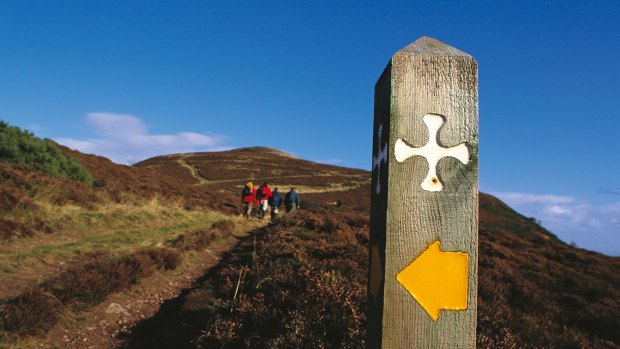
Credit: Alamy
A 100-kilometre route begins in St Cuthbert's spiritual home of Melrose, crosses into England, ending at Holy Island, Northumberland where he was buried.
THE ABRAHAM PATH, MIDDLE EAST
At 2000 kilometres, this week roughly traces the travels of Abraham (important in Judaism, Christianity and Islam). A non-religious route established in 2007, from Turkey through Egypt, Palestine, Israel and Jordan.
THE PILGRIMS' WAY, UK
This walk starts in Winchester, Hampshire and ends in Canterbury at the shrine of Thomas Becket, venerated Middle Ages saint.
FIVE OTHER MAJOR RELIGIOUS PILGRIMAGES
1. The Hajj is one of the five pillars of Islam and a visit to sacred Mecca in Saudi Arabia, the centre of the earth, is an obligation for those who are physically and financially able.
2.Buddhists revere four places for pilgrimage – Lumbini, Buddha's Nepalese birthplace. Bodh Gaya, place of enlightenment in the current Mahabodhi Temple, Bihar, India. Sarnath, formerly Isipathana, Uttar Pradesh, India where Buddha delivered his first teaching and Kusinagara, now Kushinagar, Uttar Pradesh where Buddha died and attained Parinirvana.
3.Hindus are encouraged to make pilgrimages although it's not mandatory. Almost any place can suffice but mostly pilgrim sites are sacred cities, rivers, lakes and mountains. Kumbh Mela (pictured below) is a mass pilgrimage where Hindus gather to bathe in a sacred river, often the Ganges.
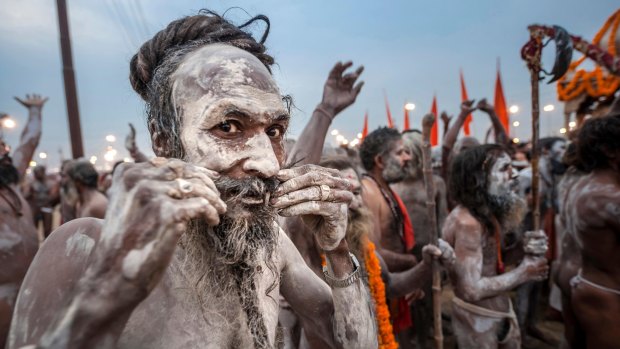
Credit: Alamy
4.In Judaism, the Western Wall or "Wailing" Wall is the most sacred and visited site. This is the remaining part of the Second Jewish Temple in the Old City of Jerusalem. There are numerous lesser Jewish pilgrimage destinations both within Israel and around the world.
5.Jerusalem is also a holy pilgrimage site for Christians (the city where Jesus preached, was crucified and buried) and Muslims – the Al Aqsa Mosque inside the Old City walls is the third holiest site in Islam after Mecca and Medina.
TRIP NOTES
WALK
Active European holiday specialist, UTracks offers self-guided and guided walking and cycling trips along the Spanish, French and Portuguese Caminos, Italy's Via Francigena and St Frances Way. UTracks' Le Puy Camino Aumont to Conques is an eight-day self-guided walk, departing daily until October 24, 2019. The tours costs from $1320 per person twin share. See utracks.com or Phone 1300 303 368.
FLY
Singapore Airlines flies from Sydney and Melbourne to Paris via Singapore. See singaporeair.com For Le Puy Camino train connections, see sncf.com/en
MORE
Alison Stewart walked as a guest of UTracks
Sign up for the Traveller newsletter
The latest travel news, tips and inspiration delivered to your inbox. Sign up now.